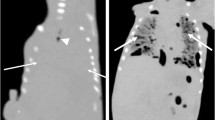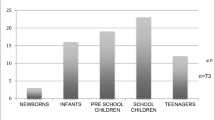Abstract
Postmortem radiology is a rapidly developing specialty that is increasingly used as an adjunct to or substitute for conventional autopsy. The goal is to find patterns of disease and possibly the cause of death. Postmortem CT images bring to light processes of decomposition most radiologists are unfamiliar with. These postmortem changes, such as the formation of gas and edema, should not be mistaken for pathological processes that occur in living persons. In this review we discuss the normal postmortem thoraco-abdominal changes and how these appear on CT images, as well as how to differentiate these findings from those of pathological processes.













Similar content being viewed by others
References
Proisy M, Marchand AJ, Loget P et al (2013) Whole-body post-mortem computed tomography compared with autopsy in the investigation of unexpected death in infants and children. Eur Radiol 23:1711–1719
Noda Y, Yoshimura K, Tsuji S et al (2013) Postmortem computed tomography imaging in the investigation of nontraumatic death in infants and children. Biomed Res Int. doi:10.1155/2013/327903
Roberts IS, Benamore RE, Benbow EW et al (2012) Post-mortem imaging as an alternative to autopsy in the diagnosis of adult deaths: a validation study. Lancet 379:136–142
O’Donoghue K, O’Regan KN, Sheridan CP et al (2012) Investigation of the role of computed tomography as an adjunct to autopsy in the evaluation of stillbirth. Eur J Radiol 81:1667–1675
Weustink AC, Hunink MG, van Dijke CF et al (2009) Minimally invasive autopsy: an alternative to conventional autopsy? Radiology 250:897–904
Thayyil S, Sebire NJ, Chitty LS et al (2013) Post-mortem MRI versus conventional autopsy in fetuses and children: a prospective validation study. Lancet 382:223–233
Oyake Y, Aoki T, Shiotani S et al (2006) Postmortem computed tomography for detecting causes of sudden death in infants and children: retrospective review of cases. Radiat Med 24:493–502
Breeze AC, Jessop FA, Set PA et al (2011) Minimally-invasive fetal autopsy using magnetic resonance imaging and percutaneous organ biopsies: clinical value and comparison to conventional autopsy. Ultrasound Obstet Gynecol 37:317–323
O’Donnell C, Woodford N (2008) Post-mortem radiology—a new sub-speciality? Clin Radiol 63:1189–1194
Rao D (2013) Post mortem changes. http://www.forensicpathologyonline.com/e-book/post-mortem-changes. Accessed 2 July 2014
Egger C, Bize P, Vaucher P et al (2012) Distribution of artifactual gas on post-mortem multidetector computed tomography (MDCT). Int J Legal Med 126:3–12
Fischer F, Grimm J, Kirchhoff C et al (2012) Postmortem 24-h interval computed tomography findings on intrahepatic gas development and changes of liver parenchyma radiopacity. Forensic Sci Int 214:118–123
Zhou C, Byard RW (2011) Factors and processes causing accelerated decomposition in human cadavers—an overview. J Forensic Legal Med 18:6–9
Teo CH, Pawita AH, Khairul O et al (2013) Post mortem changes in relation to different types of clothing. Malays J Pathol 35:77–85
Shiotani S, Kobayashi T, Hayakawa H et al (2011) Postmortem pulmonary edema: a comparison between immediate and delayed postmortem computed tomography. Legal Med 13:151–155
Barksdale KA, Perez-Costas E, Gandy JC et al (2010) Mitochondrial viability in mouse and human postmortem brain. FASEB J 24:3590–3599
Levy AD, Harcke HT, Mallak CT (2010) Postmortem imaging: MDCT features of postmortem change and decomposition. Am J Forensic Med Pathol 31:12–17
Jackowski C, Sonnenschein M, Thali MJ et al (2007) Intrahepatic gas at postmortem computed tomography: forensic experience as a potential guide for in vivo trauma imaging. J Trauma 62:979–988
Gebhart FTF, Brogdon BG, Zech WD et al (2012) Gas at postmortem computed tomography—an evaluation of 73 non-putrefied trauma and non-trauma cases. Forensic Sci Int 222:162–169
Ferreira MT, Cunha E (2013) Can we infer post mortem interval on the basis of decomposition rate? A case from a Portuguese cemetery. Forensic Sci Int 226:298
Sutherland A, Myburgh J, Steyn M et al (2013) The effect of body size on the rate of decomposition in a temperate region of South Africa. Forensic Sci Int 231:257–262
Sieswerda-Hoogendoorn T, Soerdjbalie-Maikoe V, Maes A et al (2013) The value of post-mortem CT in neonaticide in case of severe decomposition: description of 12 cases. Forensic Sci Int 233:298–303
Michiue T, Ishikawa T, Kawamoto O et al (2013) Postmortem CT investigation of air/gas distribution in the lungs and gastrointestinal tracts of newborn infants: a serial case study with regard to still- and live birth. Forensic Sci Int 226:74–80
Singh MK, O’Donnell C, Woodford NW (2009) Progressive gas formation in a deceased person during mortuary storage demonstrated on computed tomography. Forensic Sci Med Pathol 5:236–242
Christe A, Flach P, Ross S et al (2010) Clinical radiology and postmortem imaging (virtopsy) are not the same: specific and unspecific postmortem signs. Legal Med 12:215–222
Zenda T, Takayama T, Miyamoto M et al (2011) Intravascular gas in multiple organs detected by postmortem computed tomography: effects of prolonged cardiopulmonary resuscitation on organ damage in patients with cardiopulmonary arrest. Jpn J Radiol 29:148–151
Pinto DC, Haden-Pinneri K, Love JC (2013) Manual and automated cardiopulmonary resuscitation (CPR): a comparison of associated injury patterns. J Forensic Sci 58:904–909
Christe A, Aghayev E, Jackowski C et al (2008) Drowning—post-mortem imaging findings by computed tomography. Eur Radiol 18:283–290
Levy AD, Harcke HT, Getz JM et al (2007) Virtual autopsy: two- and three-dimensional multidetector CT findings in drowning with autopsy comparison. Radiology 243:862–868
Kawasumi Y, Kawabata T, Sugai Y et al (2012) Assessment of the relationship between drowning and fluid accumulation in the paranasal sinuses on post-mortem computed tomography. Eur J Radiol 81:3953–3955
Usui A, Kawasumi Y, Funayama M et al (2014) Postmortem lung features in drowning cases on computed tomography. Jpn J Radiol 32:414–420
Conflicts of interest
None
Author information
Authors and Affiliations
Corresponding author
Rights and permissions
About this article
Cite this article
Klein, W.M., Bosboom, D.G.H., Koopmanschap, D.H.J.L.M. et al. Normal pediatric postmortem CT appearances. Pediatr Radiol 45, 517–526 (2015). https://doi.org/10.1007/s00247-014-3258-8
Received:
Revised:
Accepted:
Published:
Issue Date:
DOI: https://doi.org/10.1007/s00247-014-3258-8




